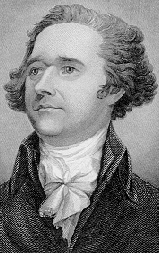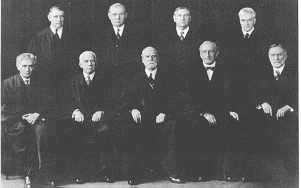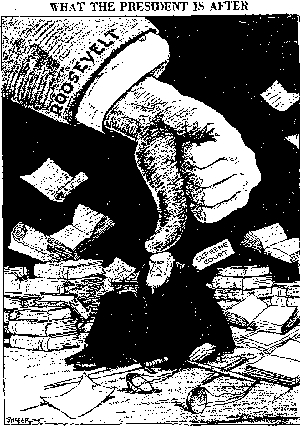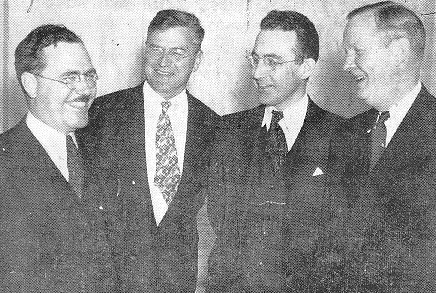Constitutionality of Social Security Act
The constitutionality of the Social Security Act was settled in a set of Supreme Court decisions issued in May 1937. The text of those decisions, with dissents, is presented here. (We also include a brief historical essay to help general readers better understand the context of the decisions.)
1937 Supreme Court Opinions
- The full text of Justice Cardozo's opinion in Helvering vs. Davis.
- The full text of Justice Cardozo's opinion in Steward Machine Co. vs. Davis, plus dissents.
- The full text of Justice Stone's opinion in Carmichael vs. Southern Coal & Coke and Gulf States Paper, plus dissent.
Other Legal Rulings
The 1937 Supreme Court Rulings on the Social Security ActBy Larry DeWitt
SSA Historian
1999
The Social
Security Act-
Preparing a report and transforming that report into a law, while
heroic in scope in many ways, is not always the end of the story.
Even though the Social Security Act was enacted into law on August
14, 1935, the country still had to hear from the Supreme Court.
This was a new untested area of federal authority and it was inevitable
that it would be challenged in the courts, and until the Supreme
Court ruled, no one could be sure that the nascent Social Security
Act would survive its infancy.
The constitutional basis of the Social Security Act was uncertain. The basic problem is that under the "reserve clause" of the Constitution (the 10th Amendment) powers not specifically granted to the federal government are reserved for the States or the people. When the federal government seeks to expand its influence in new areas it must find some basis in the Constitution to justify its action. Obviously, the Constitution did not specifically mention the operation of a social insurance system as a power granted to the federal government! The Committee on Economic Security (CES) struggled with this and was unsure whether to claim the commerce clause or the broad power to levy taxes and expend funds to "provide for the general welfare," as the basis for the programs in the Act. Ultimately, the CES opted for the taxing power as the basis for the new program, and the Congress agreed, but how the courts would see this choice was very much an open question. (See the sidebar on "A Tea Party That Changed History.")
A Dispute Among the Founders-
| The constitutional issue about the taxing power
had deep roots running all the way back to the founders and
to a dispute between Alexander Hamilton and James Madison. Although
both Hamilton and Madison were Federalists who believed in a
strong federal government, they disagreed over the interpretation
of the Constitution's permission for the government to levy
taxes and spend money to "provide for the general welfare."
Hamilton thought this meant that government could levy new taxes
and undertake new spending if doing so improved the general
welfare in a broad sense. Madison thought the federal government
could only expend money for purposes specifically enumerated
in the Constitution. The Madisonian view, also shared by Thomas Jefferson, came in time to be known as the strict construction doctrine while the Hamiltonian view is called the doctrine of implied powers. The balance between these two philosophies went one way and then the other over the years, with Hamilton's view tending to prevail over the long run, but it was always possible that in uncharted waters the courts might retreat to a Madisonian conservatism, and the Supreme Court of the early New Deal era was highly conservative in outlook. |
|
The AAA & the Social Security Act-
Already in 1934 lower courts had begun overturning major parts of the New Deal program. Potentially the most serious threat came from rulings invalidating the Agricultural Adjustment Act (AAA), which used the same broad power to levy taxes for the general welfare as the basis for its program of agricultural price supports and controls. Lower courts ruled this unconstitutional and the Supreme Court followed in January 1936, ruling that ". . .a statutory plan to regulate and control agricultural production, [is] a matter beyond the powers delegated to the federal government. . ." There was a silver lining in the cloud, however, because the same opinion ultimately sided with Hamilton on the larger question of a strict or a flexible interpretation of the general welfare clause by holding that: " . . .the power of Congress to authorize expenditure of public moneys for public purposes is not limited by the direct grants of legislative power found in the Constitution." 1
The Supreme Court's ruling on the AAA was a major rebuff for the
New Deal and it was important for Social Security as well since
it seemed to portend what lay ahead for the Social Security Act.
The AAA was an attempt to rescue farmers from the collapse of the
farm economy that happened with the coming of the Depression. It
sought to control agricultural production in order to stabilize
prices and restore farming to profitability. The actual mechanism
by which this control was to be achieved was to levy a tax on the
processing of foodstuffs and to use the proceeds from this tax to
fund agricultural subsidies--in effect, using the subsidies as "incentives"
to control production. Fearing how the courts would see this new
function of government, the framers of the AAA deliberately placed
the tax provisions and the subsidy provisions in separate titles
of the act, so they could argue that they were not necessarily connected
to each other; that is, so they could argue that the purpose of
the tax was not to control production but was merely to raise revenue.
This was the same strategy adopted by the framers of the Social
Security Act, as can be seen in the separate
Titles II and VIII of the original Social Security Act.
The old-age insurance system introduced in the Social Security Act
was designed, at a public policy level, to be a contributory social
insurance program in which contributions were made by workers to
what was called the "old age reserve account," with the
clear idea that this account would then be the source of monies
to fund the workers' retirement. Actuarial studies were done to
determine what the contribution rate would need to be in order to
have sufficient reserves in the account to pay anticipated benefits.
In the popular understanding of the program, the contributions established
an "earned right" to the eventual benefits. President
Roosevelt strenuously objected to any attempt to introduce general
revenue funding into the program. His famous quote on the importance
of the payroll taxes was: "We put those payroll contributions
there so as to give the contributors a legal, moral, and political
right to collect their pensions and unemployment benefits. With
those taxes in there, no damn politician can ever scrap my social
security program." 2
Conceptually, the old-age insurance program was a social insurance
program with an obvious connection between the taxes collected in
Title VIII of the Act and the benefits paid in Title II of the Act.
The taxing and spending provisions of the Act were placed in separate
titles in the vain hope of convincing the courts that what was obvious
was not the case--that is, so that the argument could be made that
the taxing and spending provisions had nothing to do with each other.
Whether such a strategy would work was highly questionable--especially
following the ruling on the AAA. But as it would turn out, the Court
itself would change in ways that rendered the strategy moot and
the Social Security Act safe from legal challenge.
A President Tries to Pack a Court-
In early 1937 President Roosevelt made what turned out to be the
biggest political blunder of his career, and yet it was a blunder
that would have fortuitous, even pivotal, importance for the fate
of Social Security.
Federal judges are appointed for life. The Supreme Court of the
1930s was the most elderly in the history of the Republic, with
an average age of over 71. President Roosevelt would derisively
refer to them as "those nine old men." Actually, he only
had four of them in mind. The Court was split down the middle in
political terms. On the liberal side were three justices sympathetic
to the New Deal programs (Brandeis, Stone and Cardozo); on the conservative
side were four justices who voted against everything the Congress
and the Administration tried to do (McReynolds, Butler, Van Devanter
and Sutherland). In the middle were Chief Justice Charles Evans
Hughes and Justice Owen Roberts, who were often "swing votes"
on many issues. In the spring of 1935 Justice Roberts joined with
the conservatives to invalidate the Railroad Retirement Act. In
May, the Court threw out a centerpiece of the New Deal, the National
Industrial Recovery Act. In January 1936 a passionately split Court
ruled the Agricultural Adjustment Act unconstitutional. In another
case from 1936 the Court ruled New York state's minimum wage law
unconstitutional. The upshot was that major social and political
reforms, including social insurance programs, appeared headed for
defeat. This despite the obvious will of the electorate who returned
Roosevelt to office in 1936 with the largest landslide in history.
|
|
| The 1937 Supreme Court. National Archives. |
President Roosevelt's response to all of this was stunning
and unexpected. On February 5, 1937 he sent a special message to
Congress proposing legislation granting the President new powers
to add additional judges to all federal courts whenever there were
sitting judges age 70 or older who refused to retire. Couching his
argument as a reform to help relieve the workload burden on the
courts, President Roosevelt's unusually blunt language made it clear
what he really had in mind: "A part of the problem of obtaining
a sufficient number of judges to dispose of cases is the capacity
of the judges themselves. This brings forward the question of aged
or infirm judges--a subject of delicacy and yet one which requires
frank discussion. In exceptional cases, of course, judges, like
other men, retain to an advanced age full mental and physical vigor.
Those not so fortunate are often unable to perceive their own infirmities.
. . A lower mental or physical vigor leads men to avoid an examination
of complicated and changed conditions. Little by little, new facts
become blurred through old glasses fitted, as it were, for the needs
of another generation; older men, assuming that the scene is the
same as it was in the past, cease to explore or inquire into the
present or the future." 3
The practical effect of this proposal was that the President would
get to appoint six new Justices to the Supreme Court (and 44 judges
to lower federal courts) thus instantly tipping the political balance
on the Court dramatically in his favor. The debate on this proposal
was heated, widespread and over in six months. The President would
be decisively rebuffed, his reputation in history tarnished for
all time. But the Court, it seemed, got the message and suddenly
shifted its course. Beginning with a set of decisions in March,
April and May 1937 (including the Social Security Act cases) the
Court would sustain a series of New Deal legislation, producing
a "constitutional revolution in the age of Roosevelt."
4
|
|
| One of the many cartoons of the period that were critical of FDR's court-packing plan. FDR Library. |
| A Switch in Time |
| Despite the intense controversy the court-packing plan provoked, and the divided loyalties it produced even among the President's supporters, the legislation appeared headed for passage, when the Court itself made a sudden shift that took the wind out of the President's sails. In March 1937, in a pivotal case, Justice Roberts unexpectedly changed his allegiance from the conservatives to the liberals, shifting the balance on the Court from 5-4 against to 5-4 in favor of most New Deal legislation. In the March case Justice Roberts voted to uphold a minimum wage law in Washington state just like the one he had earlier found to be unconstitutional in New York state. Two weeks later he voted to uphold the National Labor Relations Act, and in May he voted to uphold the Social Security Act. This sudden change in the Court's center of gravity meant that the pressure on the New Deal's supporters lessened and they felt free to oppose the President's plan. This sudden switch by Justice Roberts was forever after referred to as "the switch in time that saved nine." 5 |
The Supreme Court Cases-
Three Social Security cases made their way to the Supreme Court during its October 1936 term. One challenged the old-age insurance program (Helvering vs. Davis) and two challenged the unemployment compensation program of the Social Security Act. The Court would issue rulings on all three on the same day.
Helvering vs. Davis:
George P. Davis was a minor stockholder in the Edison Electric Illuminating Company. Edison, like every industrial employer in the nation, was readying itself to start paying the employers' share of the payroll tax in January 1937. Mr. Davis objected to this arguing that by making this expenditure Edison was robbing him of part of his equity, so he sued Edison to prevent their compliance with the Social Security Act. The government intervened on Edison's behalf and the Commissioner of the IRS (Mr. Helvering) took on the lawsuit.
The attorneys for Davis argued that the payroll tax was a new type of tax not listed in the Constitution's tally of taxes, and so it was unconstitutional. At one point they even introduced into their argument the definitions of "taxes" from dictionaries in 1788 (the year before the Constitution was ratified) to prove how earnest they were in the belief that powers not explicitly granted in 1789 could not be created in 1935. Davis was also of the view that providing for the general welfare of the aged was a power reserved to the states. The government argued that this was too inflexible an interpretation of the powers granted to Congress, and (loosely) that if the country could not expand the interpretation of the Constitution as it stood in 1789 progress would be impossible and it would still be 1789.
Steward Machine Company:
In the Steward Machine Company case the unemployment compensation
provisions of the Act were disputed. The Company dutifully paid
its first unemployment tax installment ($46.14) and then sued the
government to recover the payment, claiming the Social Security
Act was unconstitutional. Steward made the same as points as Davis
about the meaning of the word "tax," and argued in addition
that the unemployment compensation program could not qualify as
"providing for the general welfare."
Carmichael vs. Southern Coal & Coke
Co. and Gulf States Paper:
This was also a case disputing the validity of the unemployment
compensation program. In this variation the companies were challenging
the state portion of the federal/state arrangement. Unwilling to
pay their share of state unemployment compensation taxes the two
companies sued the state of Alabama declaring that it was the Social
Security Act, which they deemed unconstitutional, that gave Alabama
its authority to tax them in this way and since they believed the
Act to be invalid, they did not have to pay the tax. Alabama differed.
It was again the same issues as in the two prior cases.
Mr. Justice Cardozo for the Court-
On May 24, 1937 the Supreme Court handed down its decision in the
three cases. Justice Cardozo wrote the majority opinion in the first
two cases and he announced them on what was, coincidentally, his
67th birthday. (See sidebar on Justice Cardozo.)
Mirroring the situation in Congress when the legislation was considered,
the old-age insurance program met relatively little disagreement.
The Court ruled 7 to 2 in support of the old-age insurance program.
And even though two Justices disagreed with the decision, no separate
dissents were authored. The unemployment compensation provisions,
by contrast, were hotly disputed within the Court, just as they
had been the focus of most of the debate in Congress. The Court
ruled 5 to 4 in support of the unemployment compensation provisions,
and three of the Justices felt compelled to author separate dissents
in the Steward Machine case and one Justice did so in the
Southern Coal & Coke case.
Justice Cardozo wrote the opinions in Helvering vs. Davis
and Steward Machine. After giving the 1788 dictionary the
consideration he thought it deserved, he made clear the Court's
view on the scope of the government's spending authority: "There
have been statesman in our history who have stood for other views.
. .We will not resurrect the contest. It is now settled by decision.
The conception of the spending power advocated by Hamilton . . .has
prevailed over that of Madison. . ." Arguing that the
unemployment compensation program provided for the general welfare,
Cardozo observed: ". . .there is need to remind ourselves
of facts as to the problem of unemployment that are now matters
of common knowledge. . .the roll of the unemployed, itself formidable
enough, was only a partial roll of the destitute or needy. The fact
developed quickly that the states were unable to give the requisite
relief. The problem had become national in area and dimensions.
There was need of help from the nation if the people were not to
starve. It is too late today for the argument to be heard with tolerance
that in a crisis so extreme the use of the moneys of the nation
to relieve the unemployed and their dependents is a use for any
purpose [other] than the promotion of the general welfare."
And finally, he extended the reasoning to the old-age insurance
program: "The purge of nation-wide calamity that began
in 1929 has taught us many lessons. . . Spreading from state to
state, unemployment is an ill not particular but general, which
may be checked, if Congress so determines, by the resources of the
nation. . . But the ill is all one or at least not greatly different
whether men are thrown out of work because there is no longer work
to do or because the disabilities of age make them incapable of
doing it. Rescue becomes necessary irrespective of the cause. The
hope behind this statute is to save men and women from the rigors
of the poor house as well as from the haunting fear that such a
lot awaits them when journey's end is near."
With these cases decided, Justice Stone could then dispose of the
third case in short order. "Together the two statutes now
before us embody a cooperative legislative effort by state and national
governments, for carrying out a public purpose common to both, which
neither could fully achieve without the cooperation of the other.
The Constitution does not prohibit such cooperation."
6
The Social Security Board Breathes
a Sigh of Relief-
Putting the Social Security Act into operation was a massive challenge,
in some respects it was unprecedented in American history (e.g.,
the record keeping involved was on a scale never before attempted).
The Social Security Board could ill afford to wait until a definitive
Supreme Court ruling was issued before starting to work. Issuance
of social security numbers (SSNs), collection of payroll taxes,
and payment of the first lump-sum benefits all had to start by January
1937. And the Board would have to hire staff, acquire facilities,
set up record keeping procedures, and a million other things before
then. All of which it did, without knowing whether its actions were
constitutional. By the time of the court's ruling in May 1937, more
than 26 million SSNs had been issued; around $150,000,000 in taxes
had been collected; a dozen or so benefit claims had already been
paid, and there were about 150 local field offices in operation
around the country.
So we can well imagine the tension felt by the Board's employees
as the court assembled on that Monday morning in late May to hand
down its rulings. The Board's General Counsel,
Thomas Eliot, has given us a description of the moment:
"Finally came the great Monday--Monday was the Court's
'decision day'--when the Chief Justice announced the name of the
first case to be decided (Helvering vs. Davis, in which the constitutionality
of old age insurance was challenged) and, signaling that the Court's
opinion was to be read by its author, nodded to --Justice Cardozo.
Victory! My letter of May 25 began: Dear Ma 'n' Pa--Yesterday was
a big day! I hadn't really expected the decision until next week.
The result itself was not so surprising, but gratifying nevertheless.
Late yesterday afternoon Lois and I went down to see Miss Perkins
and split a bottle of (domestic!) champagne with her!"
7
|
|
| Shown leaving the Supreme Court Building after the rulings are a happy group of Administrators (left to right): Murray Latimer, Railroad Retirement Board Chairman; R. Gordon Wagenet, Unemployment Compensation Director; Arthur J. Altmeyer, Chairman of the Social Security Board; and Frank Bane, Executive Director of the Social Security Board. |
1. Quoted in Niskanen, William, "Spending legacy of a 60-year-old ruling," Washington Times, Tuesday January 30, 1996, pg. A19.
2. Schlesinger, Arthur M., Jr., The Age of Roosevelt: The Coming of the New Deal, Houghton Mifflin, 1988 American Heritage Library edition. Pgs. 308-309.
3. Quoted in Leuchtenburg, William E., The Supreme Court Reborn: The Constitutional Revolution in the Age of Roosevelt, Oxford University Press, 1995. pgs. 133-134.
4. According to Leuchtenburg's compelling history of this episode op. cit. Although the court-packing plan never made it to the Senate floor for a vote, and although various straw polls showed the plan losing by only a narrow margin, the national sentiment was overwhelmingly against the plan. President Roosevelt's political power was so damaged by the episode that his Secretary of Agriculture (and later Vice President) Henry Wallace would eventually say: "The whole New Deal really went up in smoke as a result of the Supreme Court fight." (Cf. Leuchtenburg, op. cit., pg. 158.)
5. The other "switch in time" happened on the morning of May 18, 1937 when President Roosevelt, who was breakfasting in bed, received a messenger with a letter of resignation from Justice Van Devanter. This gave the President the opportunity to appoint another liberal Justice, further strengthening his hand. And when it became clear following the Social Security Act rulings that the Court had indeed shifted course, support for the court-packing plan turned to opposition and ultimately the plan was defeated (cf. Leuchtenburg, op. cit., pgs. 143-144.).
6. Constitutionality of the Social Security Act: Opinions of the Supreme Court of the United States, U.S. Senate Document No. 74, 1937, pgs. 32, 8, 33, 48. A good summary of the issues in these cases, and their broader context, can be found in Lopez, Eduard A., "Constitutional Background to the Social Security Act of 1935," Social Security Bulletin, January 1987/Vol. 50, No. 1, pgs. 5-11.
7. Eliot, Thomas H., Recollections of the New Deal: When People Mattered, Northeastern University Press, 1992, pg. 142-143.




